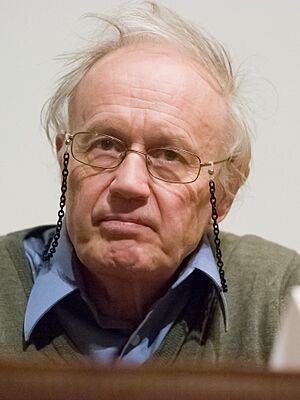Anthony James Leggett facts for kids
Quick facts for kids
Sir
Anthony Leggett
|
|
|---|---|

Leggett in 2007
|
|
| Born |
Anthony James Leggett
26 March 1938 Camberwell, London, England
|
| Citizenship | United Kingdom United States |
| Alma mater | University of Oxford (BA, DPhil) |
| Known for |
|
| Spouse(s) |
Haruko Kinase
(m. 1972) |
| Awards |
|
| Scientific career | |
| Fields | Physics |
| Institutions |
|
| Thesis | (1964) |
| Doctoral advisor | Dirk ter Haar |
| Doctoral students |
|
Sir Anthony James Leggett, born on March 26, 1938, is a famous British-American scientist. He is a theoretical physicist and a professor at the University of Illinois Urbana-Champaign (UIUC). He is known for his amazing work in low-temperature physics, especially for studying superfluidity. This important work earned him the Nobel Prize in Physics in 2003.
Professor Leggett helped us understand how special liquids like helium behave at very cold temperatures. He also explored how the rules of quantum mechanics apply to larger objects, not just tiny atoms.
Contents
Early Life and Education
Growing Up in London
Anthony Leggett was born in Camberwell, a part of South London, England. When he was a baby, World War II started. He was moved to a small village called Englefield Green in Surrey for safety. He lived there during the war. After the war, he returned to London.
His parents were both the first in their families to go to university. His father taught physics, chemistry, and mathematics at a high school. His mother also taught math for a while. Anthony has two sisters, Clare and Judith, and two brothers, Terence and Paul.
School Days
Anthony first went to a local primary school. Later, he did very well on an important test called the "11-plus." This allowed him to go to Wimbledon College. He then attended Beaumont College, a special school run by Jesuits. At Beaumont, he mostly studied classics, which was considered a very important subject back then. Even so, his father ran an evening "science club" for Anthony and his younger brother. Anthony was a very bright student and won many prizes in his final year at Beaumont.
University Studies
In 1954, Anthony won a scholarship to Balliol College, Oxford. He started at the university the next year, planning to study classics. After finishing his first degree, he decided to study physics at Merton College, Oxford.
He began his research under the guidance of Dirk ter Haar, a professor of theoretical physics. His research focused on "Some Problems in the Theory of Many-Body Systems." This topic allowed him to explore different areas. His main work was on liquid helium, looking at how it behaves as a superfluid. In 2005, the University of Oxford gave him an honorary degree.
Career and Research
Early Career Steps
After finishing his studies, Professor Leggett spent a year as a researcher at the University of Illinois Urbana-Champaign (UIUC) in the United States. He then spent another year in Japan at Kyoto University.
In 1967, he became a lecturer at the University of Sussex in England. He worked there for about 15 years. During this time, he also spent time in Japan at the University of Tokyo and in Ghana at the Kwame Nkrumah University of Science and Technology.
Return to UIUC
In 1982, Professor Leggett accepted a special position at UIUC. He moved back to Urbana, Illinois, in 1983 and has been there ever since.
His research interests changed over time. He started studying other topics like the properties of glasses at low temperatures and high-temperature superconductivity. He also worked on Bose–Einstein condensates, which are special states of matter.
Quantum Mechanics and Beyond
A big part of his work involves testing the basic ideas of quantum mechanics. He wants to see if these rules, which work well for tiny particles, also apply to larger objects that we can see in everyday life.
From 2006 to 2016, he also held a position at the Institute for Quantum Computing in Waterloo, Canada. As of 2023, he is the chief scientist at the Institute for Condensed Matter Theory at UIUC. In 2013, he helped start the Shanghai Center for Complex Physics.
His research today focuses on topics like superconductivity, superfluidity in atomic gases, and the properties of amorphous solids. He also explores deep questions about how quantum mechanics works.
In 2005, Professor Leggett had a debate with another Nobel Prize winner, Norman Ramsey. They discussed whether it's worth trying to change quantum theory. Leggett believes that quantum mechanics might not be complete because of something called the quantum measurement problem.
Awards and Honours
Professor Leggett has received many important awards and honours for his contributions to physics:
- He is a member of several important science groups, including the United States National Academy of Sciences and the Royal Society in the UK.
- In 1980, he became a Fellow of the Royal Society.
- He won the 2003 Nobel Prize in Physics. He shared this prize with V. L. Ginzburg and A. A. Abrikosov for their important work on superconductors and superfluids.
- In 2004, he was made a Knight Commander of the Order of the British Empire (KBE) by the Queen of England for his services to physics.
- He also won the Wolf Prize in Physics in 2002/2003 for his research on condensed forms of matter.
Personal Life
In June 1973, Anthony Leggett married Haruko Kinase. They met at Sussex University. In 1978, they had a daughter named Asako. Haruko earned a PhD in cultural anthropology. Their daughter, Asako, also graduated from UIUC. She has dual citizenship in the US and the UK.
See also
 In Spanish: Anthony J. Leggett para niños
In Spanish: Anthony J. Leggett para niños
- List of University of Waterloo people

